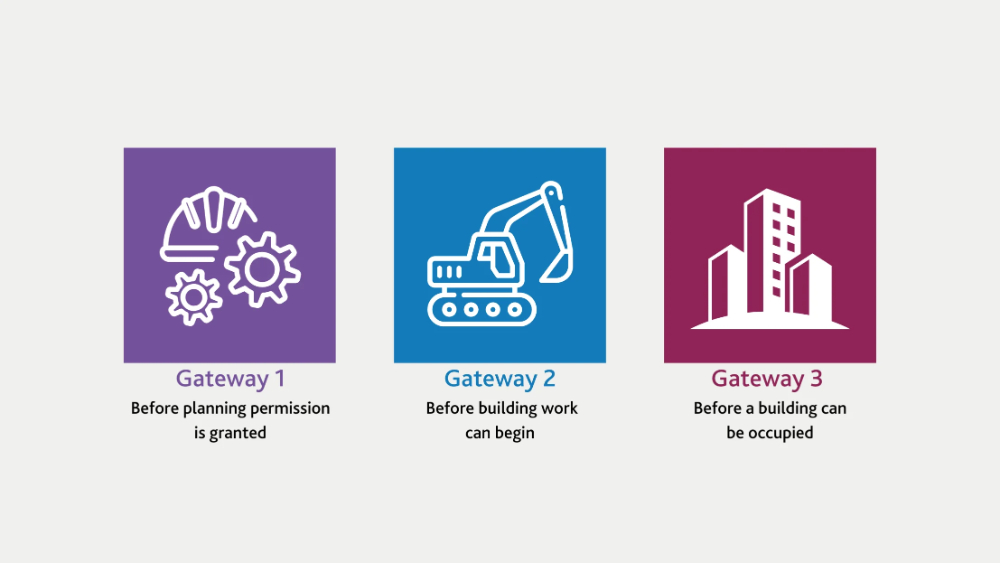- in European Union
- with readers working within the Advertising & Public Relations, Property and Construction & Engineering industries
- within Compliance topic(s)
- with Senior Company Executives, HR and Finance and Tax Executives
How we can help you
We are at the forefront of advising on the myriad of issues relating to building safety. With expertise drawn from a specialist cross-firm Building Safety team, we pride ourselves on our ability to decipher the complex web of legislation into practical, easy-to-understand advice, with clear recommendations.
The below high-level guide highlights some of the key areas of importance in the Building Safety Act 2022 (BSA) and draws together a number of our articles on various topics.
As we continue to explore the legal developments, we will update this Hub with our latest articles and resources to keep you in the loop. Be sure to bookmark this page to see our updates.
What is the Building Safety Act?
The Building Safety Act 2022 (BSA) became law in April 2022. It is the biggest legislative change affecting the design, procurement, construction and occupation of buildings for a generation (if not ever).
It creates new responsibilities for those who design, build, own or manage "higher-risk buildings" (which we describe below). However, its reach is not just limited to tall buildings: there are elements of the regime which aim to improve safety and compliance across the industry and apply to all buildings.
Enactment of the BSA was only one step in the journey to overhauling the building safety regime in England, which was brought into sharp focus by the 2017 Grenfell tower tragedy. Since receiving Royal Assent, the BSA has come into force (and continues to come into force) incrementally. It reforms existing legislation, and is also supported by extensive secondary legislation which establishes a new regulatory framework for building safety.
The BSA has made wide-reaching reforms to building safety in England and Wales (although the implementation of the regime in Wales is devolved to the Welsh Ministers). Parts of the BSA also apply in Scotland and Northern Ireland.
Explore our latest building safety articles
- Building Safety Levy: start date postponed until autumn 2026
- Can a risk rating in a fire risk assessment of the external walls (FRAEW) be a 'building safety risk'?
- Government publishes response to Grenfell Inquiry Phase 2 report
- First Building Liability Order made under the Building Safety Act 2022
- The Grenfell phase 2 report: Implications for the construction industry?
- Managing building safety – next steps for occupied higher risk buildings
- What are construction products and how are they regulated?
- Defective Premises Act 1972
What are higher-risk buildings (HRBs)?
The definition of HRBs differs slightly depending on whether the building is in (i) the design and construction phase; or (ii) the occupation phase.
Broadly speaking, during the design and construction phase, the term "higher-risk building" refers to any building in England that:
- is at least 18 metres in height or has at least seven storeys; and
- contains at least two residential units.
Care homes and hospitals that meet the height threshold also fall within the definition of HRBs in England during design and construction – but not during occupation.
Certain categories of building are excluded from the definition of HRBs in England, such as buildings comprising entirely of hotels, military accommodation and secure residential institutions.
Detailed regulations define what comprises a "building" for these purposes, and how height should be measured. Care should be taken over ascertaining whether any building falls within this category, since the application of the definition in practice is not always straight forward (particularly for mixed-use developments).
We provide support to a range of clients with determining whether their buildings fall within the legal definition of a HRB.
Who is the Building Safety Regulator?
The Building Safety Regulator (BSR) is a new body established by the BSA that sits within the Health and Safety Executive (HSE). Its objectives are to secure the safety of people in or about buildings, and to improve the standard of buildings in England. One of the ways in which it fulfils these objectives is by overseeing the new regime for higher-risk buildings (see below).
The BSA also establishes two other new bodies:
- The National Regulator for Construction Products – whose role is to oversee and enforce a stricter regulatory regime for construction products; and
- The New Homes Ombudsman – a body set up to investigate and resolve complaints about new homes.
Gain more insight into higher-risk buildings with our articles
- Building Safety: it's all in the data
- Registration of higher-risk buildings in England now underway
- Building Safety Act update: The key changes since 6 April 2024
- Managing building safety – next steps for occupied higher risk buildings
Higher-risk buildings: design and construction phase
The BSA has established a new, more stringent regulatory regime for HRBs. This came into force on 1 October 2023, with transitional arrangements in place for certain eligible projects until 6 April 2024. Building control approval for both new buildings and works to existing buildings which fall within the HRB definition, must be obtained from the BSR.
Projects will have to pass through a series of "gateways", or hard stops, at three key points during the design and construction of a higher-risk building.

Higher-risk buildings: occupation and management phase
All occupied HRBs in England must be registered with the Building Safety Regulator (BSR). The creation of a public register of HRBs is intended to ensure that information about HRBs will be provided to the BSR, who will be able to use this for the effective regulation of such buildings.
The principal accountable person (PAP) is guilty of an offence under the BSA if a HRB is occupied but not registered. The consequences of breach are onerous and include an unlimited fine and up to two years' imprisonment.
Duties of accountable person/principal accountable person
During the occupation of an HRB, the BSA establishes the concept
of the "accountable person" (AP) and "principal
accountable person" (PAP). These are clearly defined
dutyholders who can be held to account and will have statutory
obligations for ensuring that fire and structural safety is being
effectively managed in HRBs during the occupation phase.
There are detailed rules governing who the AP/PAP will be.
Identifying the AP/PAP is not always straightforward, particularly
where there are complex ownership structures. This may occur, for
example, where there are multiple layers of leasehold tenures
(perhaps with varying demises and/or repairing obligations). It may
also occur where there is split ownership between residential and
commercial parts of a building, and/or where a management company
is involved.
Among other things, the duties of the AP and PAP include:
- Applying for registration of occupied HRBs.
- Submitting 'key building information' in respect of those HRBs.
- Producing a safety case report which demonstrates that building safety risks have been assessed and all reasonable steps have been taken to prevent building safety risks materialising, and to mitigate the severity of an incident if it does occur.
- Preparing a Resident Engagement Strategy.
- Establishing and operating a mandatory occurrence reporting system.
The Golden Thread
The BSA places a legal duty on the duty holders during design and construction and APs/PAPs to create and maintain a "golden thread" throughout a building's life cycle. This is defined as the information that allows you to understand a building and the steps needed to keep both the building and people safe, now and in the future. It must be easily accessible so that it can be quickly handed over to those who need it, which includes Fire and Rescue Services, the Building Safety Regulator (BSR) and other building control bodies.
Government guidance has confirmed that the golden thread must:
- be stored digitally;
- be kept securely;
- represent the building's "single source of truth";
- be accessible - and provided in a simple format, in plain English, so that it is easy to understand;
- be proportionate (taking into account the stage the building is at in its life); and
- when the building is occupied, include details of how building safety risks are being assessed and managed.
We provide further detail in our insight: Building safety: it's all in the data!
Dutyholders – all buildings
A common misconception about the BSA is that it is only relevant
to HRBs. This is not the case: there are some elements of the BSA
of wider relevance and which apply to all "building work"
(as defined in the Building Regulations 2010). There are only very
limited exceptions for "exempt" work and minor
works.
The key change applicable to all new building works is the new
dutyholder and competence regime in Part 2A of the Building
Regulations 2010: Building Regulations in England – new
dutyholders.
This new regime:
- creates roles for specified dutyholders during design and construction;
- sets out the duties that they must comply with;
- sets out the competence requirements for individuals and organisations who may hold those roles; and
- identifies an additional 'layer' of duties and roles that the dutyholders will have on any project involving HRB work.
Anyone procuring building works will need to review their project arrangements and procurement processes to ensure that they are suitable to enable compliance under the new regime.
Stronger enforcement regime and increased penalties for breach
Almost all building work carried out in England must comply with building regulations. Historically, however, the sanctions for breaching these were minimal. The Hackitt Report notably described the penalties as "so small as to be an ineffective deterrent".
The BSA seeks to remedy this by providing for stronger penalties for breach of building regulations: with an unlimited fine and imprisonment of up to two years as possible sentencing options.
In certain circumstances, the BSA also extends liability for such breaches to individual directors, managers, secretaries or other similar officers of a body corporate, or partners within a partnership.
For more information, see our insight: Building Safety Act: potential personal liability of directors.
New remedies under the Building Safety Act
Remediation orders
Remediation orders (ROs) may be made by the First-tier Tribunal (FTT) under section 123 BSA, requiring the party with responsibility for repair of the external façade to undertake repairs. Remediation orders may be made in respect of "relevant buildings" as defined in section 117 BSA.
Remediation contribution orders
Remediation contribution orders (RCOs) are concerned with the funding of those remediation works. The FTT has the power to make a RCO under section 124 BSA – if it considers it "just and equitable" to do so. RCOs may be made against landlords / developers and their "associated persons" (defined in section 121 BSA), requiring them to make payments in connection with the remediation of relevant defects.
Building liability orders
Building liability orders (BLOs) are orders that may be made by the High Court – again if the Court considers it "just and equitable" to do so. They are orders which extend a "relevant liability" of a body corporate (Party A) so that it will also be a liability of an "associated" body corporate (Party B). Parties A and B may then become jointly and severally liable for the relevant liability.
Leaseholder protections
ROs, RCOs and BLOs form part of what are collectively referred to as the "leaseholder protections" established by the BSA. These aim to protect leaseholders in multi-occupied residential buildings from the costs associated with remediating historical building safety defects.
Schedule 8 of the BSA affords further protection to leaseholders by providing:
- that certain service charge amounts relating to "relevant defects" in a "relevant building" are not payable; and
- for the recovery of those amounts from persons who are landlords under leases of the building (or any part of it).
We have written about the leaseholder protections in our insights:
- Tribunal considers leaseholder protections
- Leaseholder protection, extended civil liabilities and a new cause of action.
Increased scope of the duty under the Defective Premises Act 1972, and extended limitation periods
One of the most talked about consequences of the BSA is to widen the scope of, and extend the limitation periods for claims under the Defective Premises Act 1972 (DPA).
Section 1(1) of the DPA imposes a duty on those "taking on work for or in connection with the provision of a dwelling" to see that the work is done in a workmanlike or professional manner, with proper materials, and "so that the dwelling will be fit for habitation when completed". This has been widened: claims are now no longer limited to the original "provision" of a dwelling but can now be brought in respect of "any work undertaken on an existing dwelling, provided that work is done in the course of a business".
Previously, the limitation period to bring a claim under section 1 of the DPA was six years from completion of a dwelling. The BSA extended this to a 30-year limitation period for dwellings completed before 28 June 2022, or 15 years for dwellings completed after 28 June 2022.
In URS v BDW, the Supreme Court confirmed that it is open to parties in ongoing litigation to seek amendments and potentially revive previously time-barred defects claims under the DPA. This case was heard by a panel of seven justices - reflecting its importance and wide-ranging impact, and also confirmed that:
- The retrospective 30 year limitation period established by the BSA extends not only to DPA claims but also to "onward" claims in the tort of negligence or for contribution;
- Developers can both be owed and owe a duty under the DPA; and
- Notwithstanding that the developer in this case had not entered into any settlement with individual homeowners (or indeed faced any such claims), the damages it claimed are recoverable as a point of principle under the Contribution Act.
Find out more about the URS v BDW Supreme Court decision.
Take a deeper look at remediation orders, remediation contribution orders and building liability orders with our insights.
- Remediation contribution order granted by the First-tier Tribunal under the Building Safety Act 2022
- First substantive remediation contribution order granted by the First-tier Tribunal
- Remediation order granted by the First-tier Tribunal under the Building Safety Act 2022
- BSA: building liability orders
Building Safety in Wales
Although certain parts of the BSA do apply in Wales, the Welsh Government has powers under the BSA to implement secondary legislation setting out its own building safety regime in Wales.
A key difference is that the BSR has no jurisdiction in Wales.
A further key difference relates to the definition of "higher-risk building" in Wales. The requirement is Wales is only for a single residential unit (as compared with two residential units in England) for a building which meets the height threshold to qualify as a HRB. In Wales, children's homes are also included within the definition.
The Welsh Government has also recently confirmed that the Building Safety (Wales) Bill is on track for introduction in summer 2025 and is expected to capture all multi-occupied residential buildings in Wales, and not just buildings of 18 meters and above.
For more information on the position in Wales, see our insights:
- Welsh Government proposes new building safety regime for higher risk buildings
- Welsh Building Safety Bill 2025: occupation phase regime expected to apply to all multi-occupied residential buildings irrespective of height
- Definition of higher-risk buildings in Wales
- Building safety: higher-risk buildings in Wales.
Read the original article on GowlingWLG.com
The content of this article is intended to provide a general guide to the subject matter. Specialist advice should be sought about your specific circumstances.




